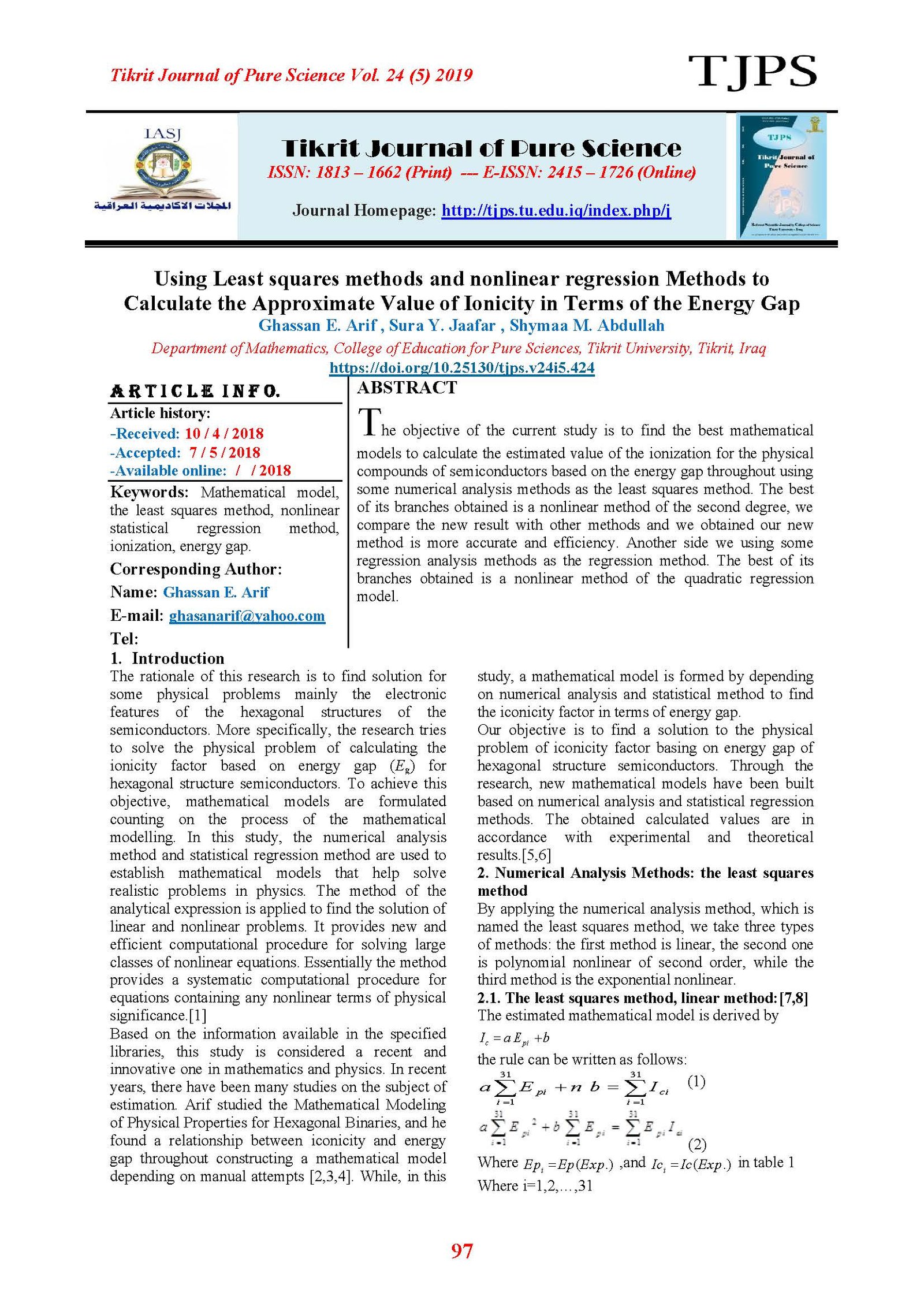Using Least squares methods and nonlinear regression Methods to Calculate the Approximate Value of Ionicity in Terms of the Energy Gap
Main Article Content
Abstract
The objective of the current study is to find the best mathematical models to calculate the estimated value of the ionization for the physical compounds of semiconductors based on the energy gap throughout using some numerical analysis methods as the least squares method. The best of its branches obtained is a nonlinear method of the second degree, we compare the new result with other methods and we obtained our new method is more accurate and efficiency. Another side we using some regression analysis methods as the regression method. The best of its branches obtained is a nonlinear method of the quadratic regression model.
Article Details

This work is licensed under a Creative Commons Attribution 4.0 International License.
Tikrit Journal of Pure Science is licensed under the Creative Commons Attribution 4.0 International License, which allows users to copy, create extracts, abstracts, and new works from the article, alter and revise the article, and make commercial use of the article (including reuse and/or resale of the article by commercial entities), provided the user gives appropriate credit (with a link to the formal publication through the relevant DOI), provides a link to the license, indicates if changes were made, and the licensor is not represented as endorsing the use made of the work. The authors hold the copyright for their published work on the Tikrit J. Pure Sci. website, while Tikrit J. Pure Sci. is responsible for appreciate citation of their work, which is released under CC-BY-4.0, enabling the unrestricted use, distribution, and reproduction of an article in any medium, provided that the original work is properly cited.
References
[1] Pisani, C., Dovesi, R., & Roetti, C. (1988). Different Approaches to the Study of the Electronic Properties of Periodic Systems. In Hartree - Fock ab initio treatment of crystalline systems (pp. 1-33). Springer Berlin Heidelberg [2] Skoog, D. A., Holler, F. J., & Crouch, S. R. (2017). Principles of instrumental analysis. Cengage learning. [3] Wold, S., Ruhe, A., Wold, H., & Dunn, III, W. J. (1984). The collinearity problem in linear regression. The partial least squares (PLS) approach to generalized inverses. SIAM Journal on Scientific and Statistical Computing, 5(3), 735-743.
[4] Arif, G. E., Abdullah, F. A., & Al-Douri, Y. (2014). Modeling of the Electronic Properties of Hexagonal Semiconductors. Advanced Materials Research Vol. 925, pp. 364-368. [5] William L. Oberkampf, Christopher J. Roy. “Verification and Validation in Scientific Computing”. Cambridge University Press. 2010.
[6] Arif, G. E., Al-Douri, Y. “Mathematical Modeling of Physical Properties for Hexagonal Binaries”. Scholar’s Press, Germany. 2016.
[7] Sastry S. (2012). PHI- Learning Pvt. I. td., " Introductory Methods of Numerical Analysis "
[8] أميل صبحي سعد شكر الله, ) 2001 (, التحليل العددي التطبيقي,
النظرية التقنيات والطرق التقريبية, المطبعة مؤسسة بيتر للطباعة -
والتوريدات القاهرة مصر – –
[9] Grundmann, M. (2010). The physics of semiconductors: an introduction including nanophysics and applications (2nd ed.). New York: Springer-Verlag.
[10] Senthil, J K., Tak, Y., Seol, M., & Yong, K. (2009). Synthesis and Characterization of ZnO Nanowire – CdO Composite Nanostructures, Nanoscale Research Letters 4, 1329-1334.
[11] Palik, E. D. (1991). Handbook of optical constants of solids II. New York: Academic Press.
[12] Schröer, P., Krüger, P., & Pollmann, J. (1993). First-principles calculation of the electronic structure of the wurtzite semiconductors ZnO and ZnS. Physical Review B, 47(12), 6971-6980. [13] Niesert, M. (2011). Ab initio calculations of spin-wave excitation spectra from time-dependent density - functional theory (Vol.38). Forschungszentrum Jülich.
[14] Reshak, A. H. (2013). Crystals structure, linear and nonlinear optical susceptibilities. Malaysia: Universiti Malaysia Perlis. [15] Nelles, O. (2013). Nonlinear system identification: from classical approaches to neural networks and fuzzy models. Springer Science & Business Media.
[16] Douglas C. Montgomery ,(2012) ,by John Wiley, and Sons, Inc " Introduction to Linear Regression analysis.
[17] أموري هادي كاظم الحسناوي, ) 2002 (, طرق القياس
الاقتصادي , دار وائل للنشر عمان الاردن.
